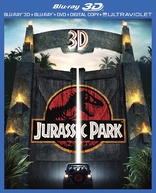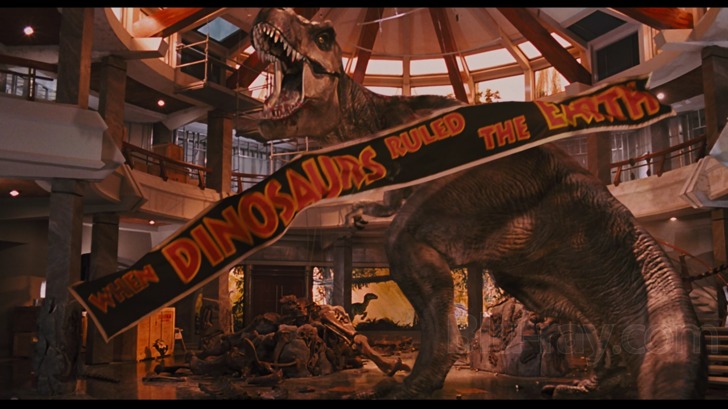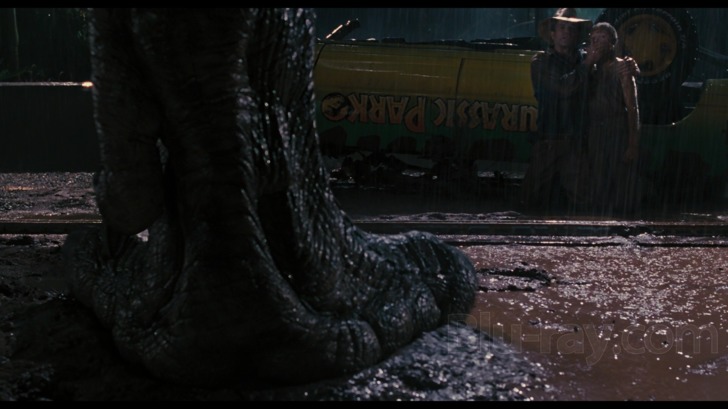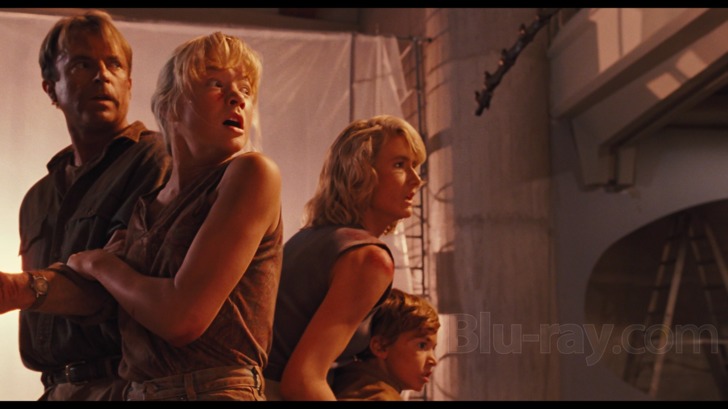Jurassic Park 3D Blu-ray Movie
HomeJurassic Park 3D Blu-ray Movie 
Blu-ray 3D + Blu-ray + DVD + UV Digital CopyUniversal Studios | 1993 | 127 min | Rated PG-13 | Apr 23, 2013

Movie rating
8.7 | / 10 |
Blu-ray rating
| Users | 4.4 | |
| Reviewer | 4.0 | |
| Overall | 4.3 |
Overview
Jurassic Park 3D (1993)
On a remote island where an amazing theme park with living cloned dinosaurs is located, five people must battle to survive among the prehistoric predators when the security system breaks down and the beasts are released from their enclosures.
Starring: Sam Neill, Laura Dern, Jeff Goldblum, Richard Attenborough, Bob PeckDirector: Steven Spielberg
| Adventure | Uncertain |
| Action | Uncertain |
| Sci-Fi | Uncertain |
| Thriller | Uncertain |
Specifications
Video
Video codec: MPEG-4 MVC
Video resolution: 1080p
Aspect ratio: 1.85:1
Original aspect ratio: 1.85:1
Audio
English: DTS-HD Master Audio 7.1 (48kHz, 24-bit)
English: DTS 5.1 (768 kbps)
French: Dolby Digital 5.1 (384 kbps)
Spanish: Dolby Digital 5.1
English: DTS 2.0
Spanish Dolby Digital 5.1 and English DTS 2.0 are both 384 kbps.
Subtitles
English SDH, French, Spanish
Discs
50GB Blu-ray Disc
Three-disc set (2 BDs, 1 DVD)
UV digital copy
DVD copy
BD-Live
Blu-ray 3D
D-Box
Packaging
Slipcover in original pressing
Playback
Region free
Review
Rating summary
| Movie | 4.5 | |
| Video | 3.5 | |
| Audio | 5.0 | |
| Extras | 4.0 | |
| Overall | 4.0 |
Jurassic Park 3D Blu-ray Movie Review
The film's solid 3D showing doesn't quite mask its transfer's shortcomings...
Reviewed by Kenneth Brown April 16, 2013Jurassic Park 3D is about to be overshadowed by yet another debate surrounding a Universal video presentation. So, for forum regulars: keep it civil, gentlemen. That said, let's begin at the beginning. The latest release of Jurassic Park features a new transfer; one created specifically for the movie's recent 3D conversion using a new fully restored, color-corrected 4K master of the film's original 35mm negative, all approved by director Steven Spielberg. The 3D release also boasts a new DTS-HD Master Audio 7.1 surround track, which delivers a slightly fuller, more dynamic sonic experience courtesy of original sound designer Gary Rydstrom. However, the new master, new transfer and new lossless audio mix are only offered on the 3-disc set's 3D disc, which is, unfortunately for some, 3D-locked. To view the new AV presentation in 3D or 2D, a 3D display and 3D Blu-ray player (or a 3D-ready computer with a 3D Blu-ray drive) are required. The second disc in the set can be viewed on 2D home theaters, but its AV presentation is identical to its 2011 counterpart.

To read staff reviewer Jeffrey Kauffman's take on Jurassic Park and its 2011 Blu-ray release, click here. For the purposes of this review, I'll be focusing on the new 3D presentation, the differences between the 2013 and 2011 versions, and the 3D presentation's new 7.1 lossless audio remix.
Jurassic Park 3D Blu-ray Movie, Video Quality 

Jurassic Park's new master may be 4K but, sadly, Universal's subsequent MVC-encoded transfer doesn't show the benefits of a 4K source. Noise reduction and other less savory techniques have clearly been employed at some point in the production chain, either at the restoration stage or, as is much, much more likely, during the film's 3D conversion, long after the original 35mm elements were properly preserved for future high definition releases. (Fingers crossed.) Grain graces the image, or rather what's left of it. For the most part, the film's grain field has all but been wiped away, and along with it a fair amount of fine detail, cursing the image with a bit of that telltale "mushy" appearance that always ruffles purists' feathers. It comes as something of a disappointment too. A shock even, if I'm being honest. It's more than possible in this day and age to reduce noise and retain the subtlest details. (Warner tends to make it look like child's play, preserving the filmic nature of a remastered or restored source while tweaking various aspects of the image.) Here, closeups exhibit mild to moderate fine detail, but nothing that in any way suggests the use of a 4K source. Midrange and wide shots are even more problematic. Slight smearing and a prevailing smudginess is apparent throughout, and very few scenes can be described as crisp, much less well-resolved.
That said, it's not nearly as distracting in motion as some will no doubt claim. The 2011 transfer is dramatically sharper, yes, but primarily because artificial sharpening and edge enhancement have been applied so liberally and, to be blunt, needlessly. On one hand, the 2011 encode is arguably more striking, with razor-sharp edges, pinpoint textures and more forgiving delineation. All valid reasons to appreciate the previous release. On the other hand, the post-sharpening subjects the 2011 encode to problems all its own. Grain is present, but occasionally undermined and undone by glaring video noise; edge halos and ringing are frequent offenders; and, in some regards (namely color and contrast), the transfer is less representative of Spielberg's intentions and the film's original theatrical presentation.
So yes, the 2013 transfer suffers a loss in detail. That shouldn't be up for debate. However, what it gains will certainly appeal to many a cinephile. Specifically, it's been granted a notably warmer, more fittingly temperate color palette, as well as more lifelike fleshtones, richer blacks and more cinematic contrast leveling, which leads to darker, more evocative and more suspenseful sequences. Some will call the "new" color timing everything from muddy to murky, and that's fair. It is muddier and murkier than its 2011 brother in arms. Even so, the 2013 transfer exchanges the blue-tinted science fiction sheen of the 2011 presentation for earthier, more natural jungle island hues, bringing it more in line with the tone Spielberg struck in 1993.
The lagging detail is even less of a noticeable problem in 3D. For a conversion, the film's 3D is quite impressive, even though some scenes -- the Gallimimus stampede springs to mind -- have a bit of the staggered plane, pop-up storybook look that briefly yanks me out of an otherwise enveloping 3D presentation. Depth is reasonably convincing, dimensionality is nicely realized and a number of foreground elements have a wonderful pop that's neither underwhelming nor gimmicky. There also aren't any major 3D anomalies. Aliasing isn't at play, crosstalk-prone shots and background elements are few and far between, and the encode is largely free of artifacting, banding and other unsightly nuisances. Some ringing still makes its way into the image (especially when hot, white skies frame an actor or dinosaur), but nothing as considerable as that which spoils entire scenes in the 2011 presentation.
All told, some will prefer the new 2013 transfer, especially those who enjoy its more faithful and cinematic qualities. Others, though, will prefer the 2011 transfer, as it provides a more obvious (but more superficial) high definition upgrade. Neither camp will be right, neither camp will be wrong, as both presentations are far from ideal. Hopefully, in the not too distant future, a third release will appear on the horizon. One born from the restored, Spielberg-approved 4K master that hasn't been subjected to rampant artificial sharpening or detail-quashing noise reduction; a truly faithful, unmistakably filmic presentation (available to all in 3D and 2D) that delivers the best of both worlds, minus the separate imperfections, shortcomings and technical limitations that hinder each transfer, for one reason or another, from being declared the definitive version of Jurassic Park.
- Jurassic Park 3D (2013) Video Quality: 3.5/5.0
- Jurassic Park (2011) Video Quality: 3.5/5.0
- Jurassic Park 3D (2013) 3D Experience: 4.0/5.0
Jurassic Park 3D Blu-ray Movie, Audio Quality 

First things first: there is absolutely nothing wrong with the 2011 DTS-HD Master Audio 7.1 surround track. The new 2013 7.1 remix is, by sound designer Gary Rydstrom's own admission, a chance to revisit and revise he and his team's original work. So it isn't an improvement; it's simply a revision, and a relatively subtle one at that. Most listeners won't pick up on the differences (I was actively comparing and contrasting the two, and I'm sure I still missed some), but each one does alter the experience for the better. Tyrannosaurus roars are more ear-splitting and unsettling, the island's vistas and jungles are a touch more immersive, and the entire soundfield is a bit more refined. With twenty additional years under his industry belt, Rydstrom expands upon his previous efforts and has a little fun in the process, adjusting the new mix to take better advantage of the LFE channel and rear speakers. It's a more modern take on a classic sonic monster, and yet doesn't trample the previous mix's corpse. More faithful than anything else, it preserves anything and everything that made the previous 7.1 track a terrific catalog standout and simply adds more seasoning to the sauce. Everything else is exactly as it should be. Dialogue is crystal clear and perfectly prioritized. LFE output shakes the ground and scatters the kiddies. The rear speakers bite down on any and every directional effect, pan and hint of ambience tossed their way. And dynamics and separation are exceptional. I don't have a single complaint. I didn't in 2011 either. Both tracks warrant high marks.
Jurassic Park 3D Blu-ray Movie, Special Features and Extras 

Exclusive 3D Version Special Features
- The World of Jurassic Park 3D (Disc 1, HD, 9 minutes): The only exclusive bonus included with the new release is a strong one, although a lengthier documentary would have added further value. "World" explores the film's conversion by way of interviews with Spielberg, the StereoD conversion team and other key members of the 3D release, as well as its remixed sound design.
2D Version Special Features
-
The following supplement overviews were written by staff reviewer Jeffrey Kauffman in 2011
- Return to Jurassic Park: Dawn of a New Era (Disc 2, HD, 25 minutes): The first part of this all-new documentary concentrates on the seismic sea change that the filmmakers encountered when they realized that CGI was the way to most effectively create many of the special effects in the film.
- Return to Jurassic Park: Making Prehistory (Disc 2, HD, 20 minutes): This section concentrates on the film's impressive production design with regard to recreating the Jurassic era on film, most of which was done on soundstages. There's also some cool footage of some stop-motion previz work done on some sequences.
- Return to Jurassic Park: The Next Step in Evolution (Disc 2, HD, 15 minutes): This is a more in-depth look at the development of the CGI elements in the film, many of which were composited very late in the production. The learning curve was steep and incredibly fast on this film, since this was such a new technology at the time, with some shots being improved literally on a day to day basis.
- Archival Featurettes (Disc 2, SD, 66 minutes):
- The Making of 'Jurassic Park' - A very well done, generalist overview of the production of the film.
- Original Featurette - A brief promo piece that probably ran as a quasi-trailer theatrically.
- Steven Spielberg Directs 'Jurassic Park' - An interesting look at the director on set and on location.
- Hurricane in Kauai - A category 5 hurricane hit Hawaii where the filmmakers were doing location shooting.
- Behind the Scenes (Disc 2, SD, 26 minutes):
- Early Pre-Production Meetings
- Location Scouting
- Phil Tippett Animatics: Raptors in the Kitchen
- Animatics: T-Rex Attack
- ILM and 'Jurassic Park': Before and After Visual Effects
- Foley Artists
- Storyboards
- Production Archives
- Jurassic Park: Making the Game (Disc 2, HD, 5 minutes): A quick look at a game produced by Telltale.
- Theatrical Trailer (Disc 2, SD, 1 minute):
Jurassic Park 3D Blu-ray Movie, Overall Score and Recommendation 

So we come at last to the question: does Jurassic Park 3D belong in my collection? If you don't have a 3D display and 3D player, the answer is simple. No, the primary disc is 3D-locked, meaning the new restoration and transfer, new 7.1 lossless remix and new HD featurette will only be accessible to those with the proper equipment. If you do have all the 3D fixin's, the answer is a bit tougher. The new video presentation resolves many of the issues that afflicted the 2011 transfer, but brings with it several additional problems, obvious noise reduction chief among them. The main draw turns out to be something of a toss-up; some will prefer the 2011 transfer, some will prefer the 2013 transfer. You'll have to see both for yourself to make whatever decision is best for you. Thankfully, the DTS-HD Master Audio 7.1 remix isn't subject to any disappointment. It's as monstrous as its 2011 counterpart, and has a few welcome tricks up its sleeve. All in all, whether or not you purchase Jurassic Park 3D comes down to a few too many subjective judgment calls. Perhaps the next time Universal releases the film on Blu-ray we'll be able to at long last call it the definitive version. Commendable as it is in many ways, this still isn't it.
Other editions
Jurassic Park: Other Editions

Jurassic Park
20th Anniversary Edition
1993

Jurassic Park
Limited Edition
1993

Jurassic Park
1993

Jurassic Park 3D
Jurassic World Fandango Cash
1993

Jurassic Park
Jurassic World Fandango Cash
1993

Jurassic Park
Collectible Metal Packaging
1993

Jurassic Park
1993

Jurassic Park
1993

Jurassic Park 4K
1993

Jurassic Park 4K
30th Anniversary - Universal Essentials Collection
1993

Jurassic Park 4K
1993

Jurassic Park
Iconic Moments
1993

Jurassic Park 4K
Remastered
1993
Similar titles
Similar titles you might also like

Jurassic World: Fallen Kingdom
2018

The Lost World: Jurassic Park
1997

Jurassic Park III 4K
2001

Jurassic World
2015

Godzilla 4K
2014

Riddick 4K
2013

Ready Player One 4K
2018

TRON: Legacy
2010

Godzilla: King of the Monsters 4K
2019

Prometheus 4K
2012

Independence Day 4K
20th Anniversary Edition
1996

World War Z
2013

Godzilla x Kong: The New Empire 4K
2024

After Earth
2013

Rampage
2018

Maze Runner: The Scorch Trials
2015

The Matrix 4K
1999

Kong: Skull Island 4K
2017

Pacific Rim 4K
2013

Star Wars: Episode V - The Empire Strikes Back 4K
1980